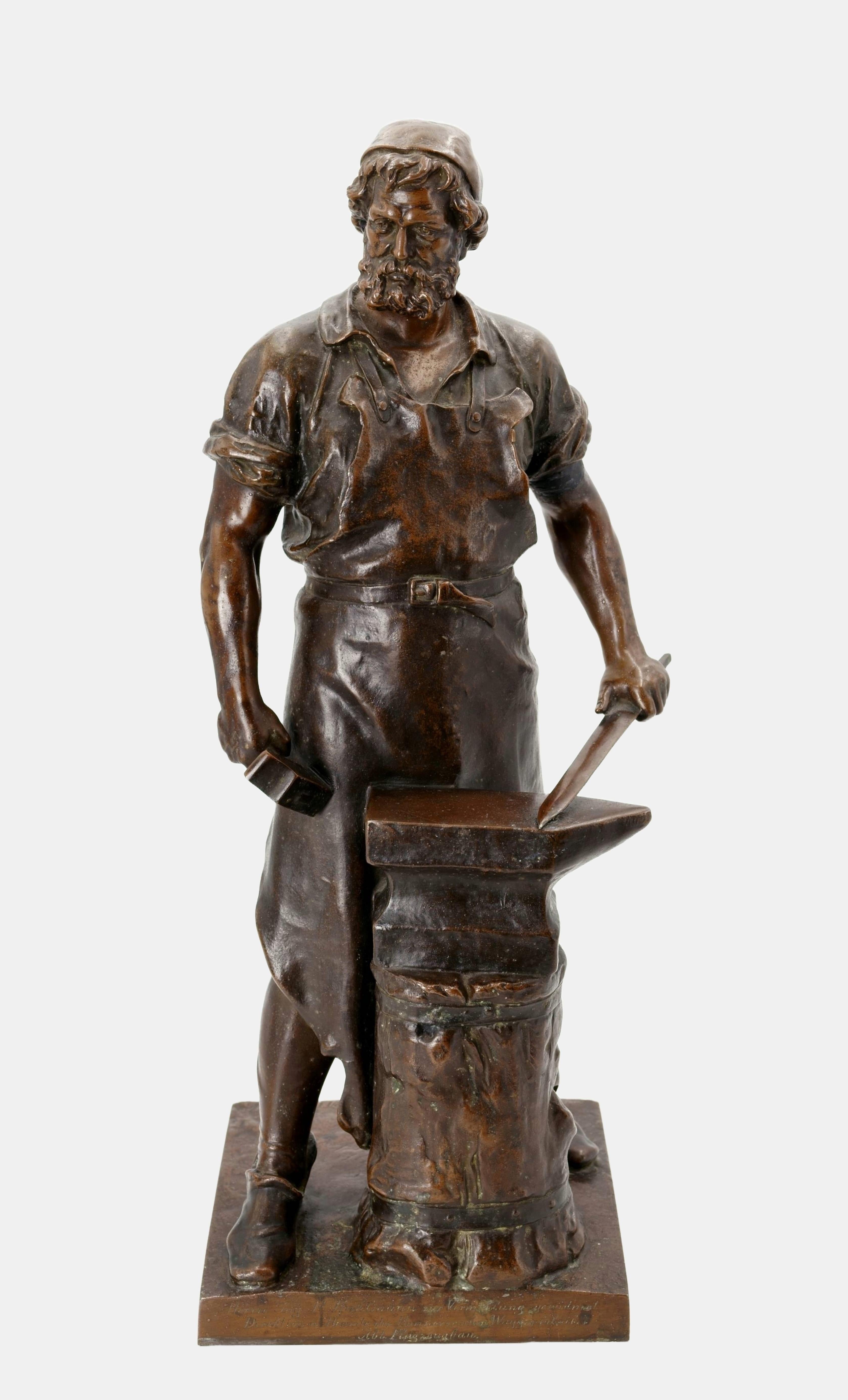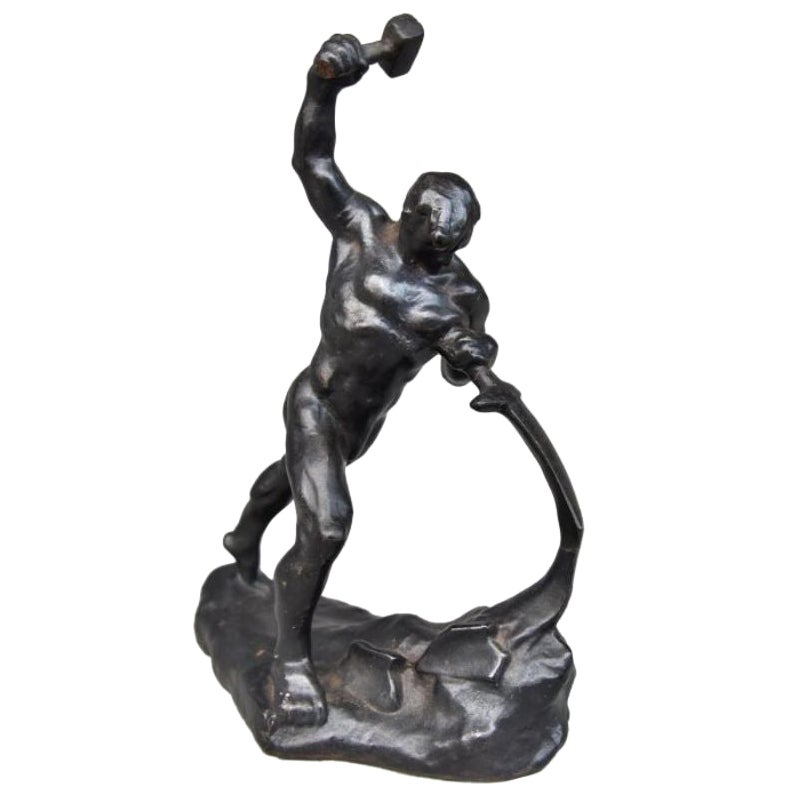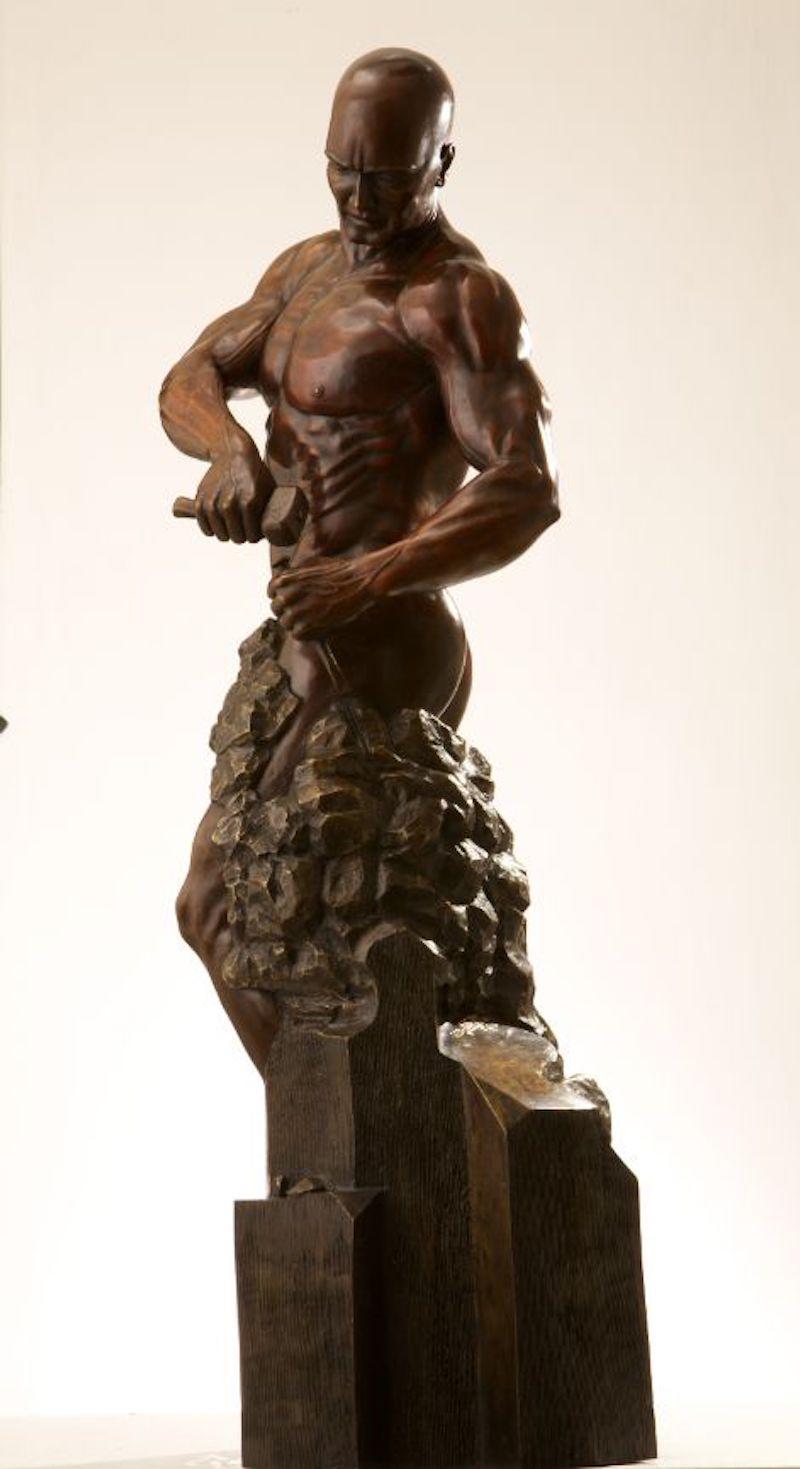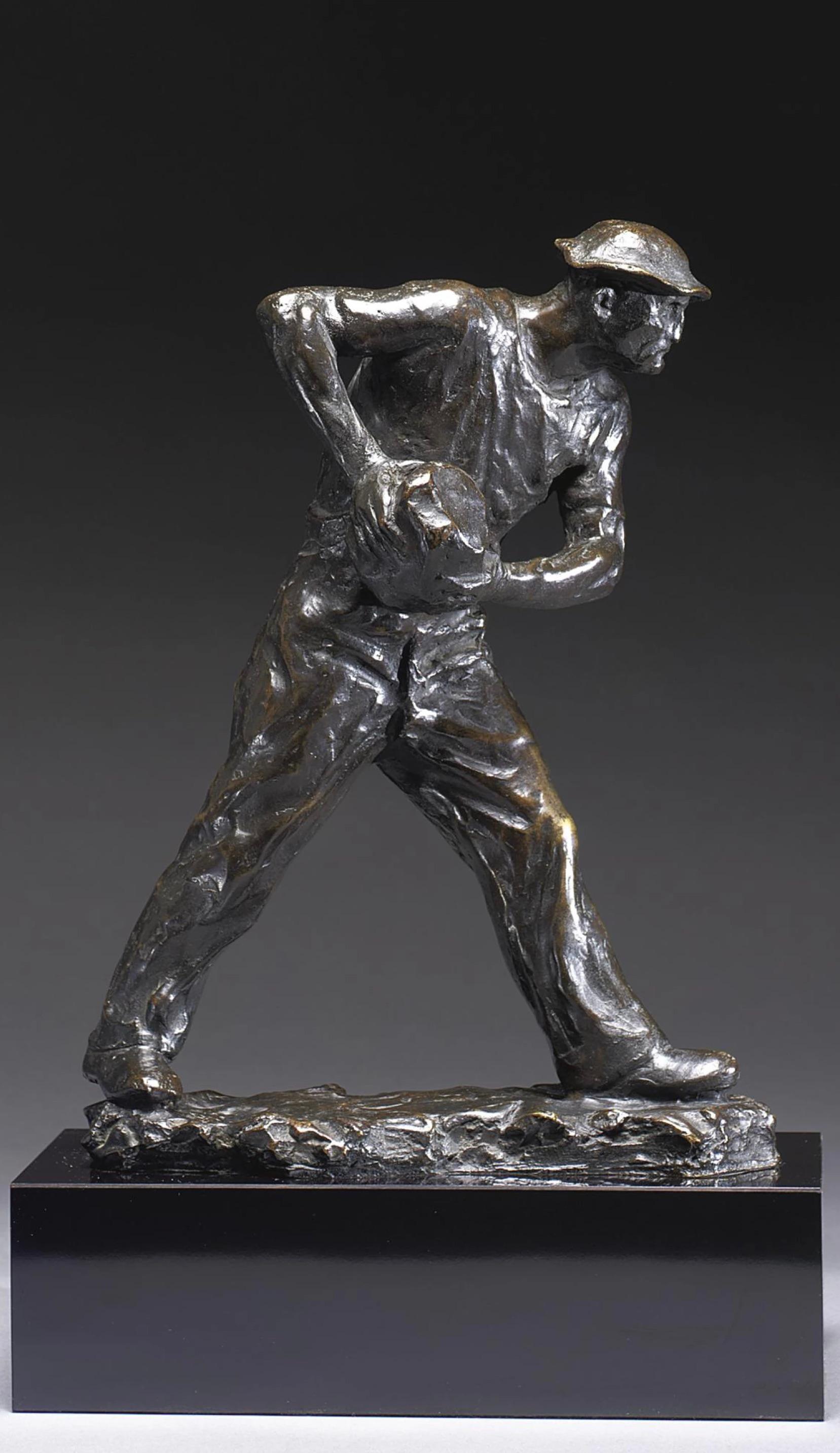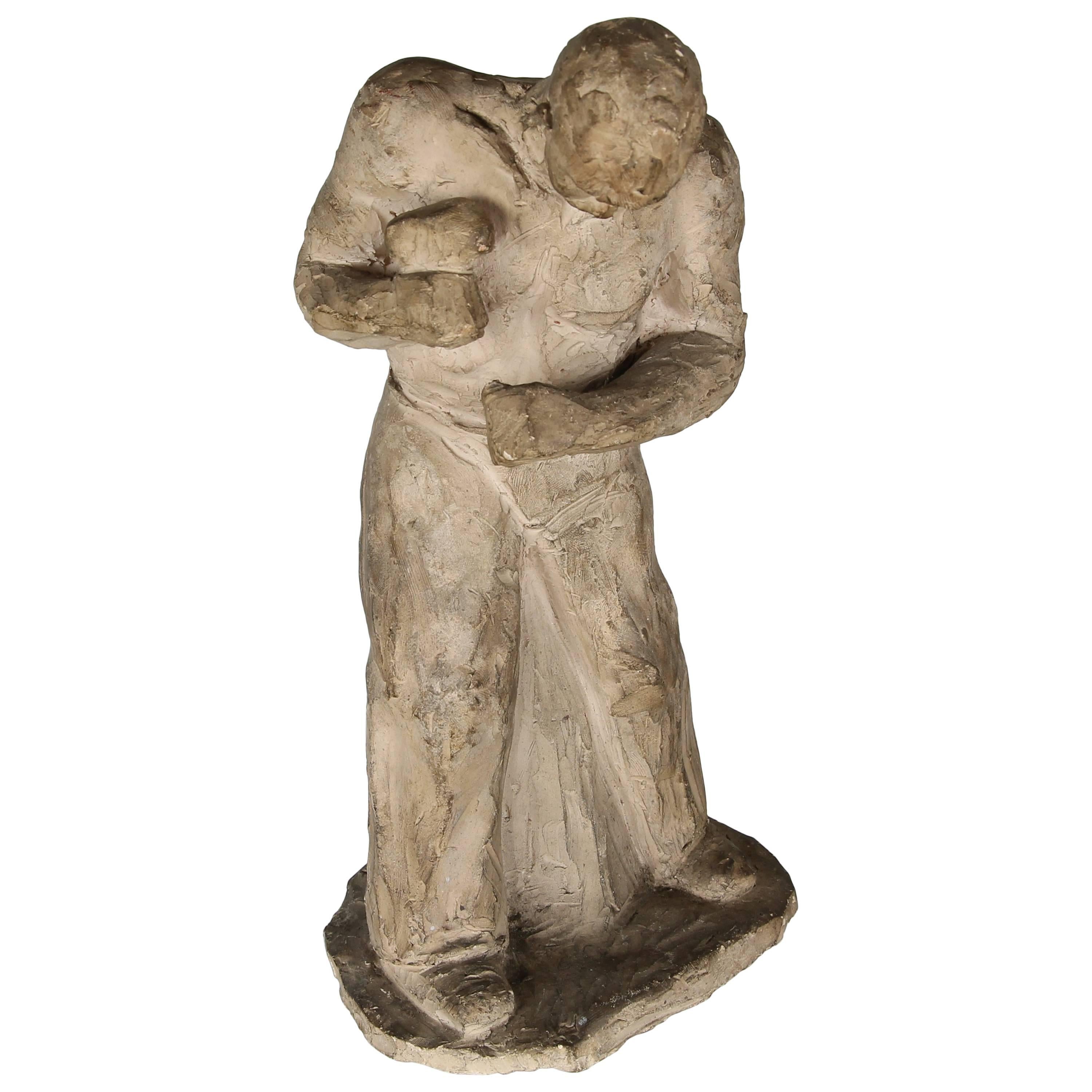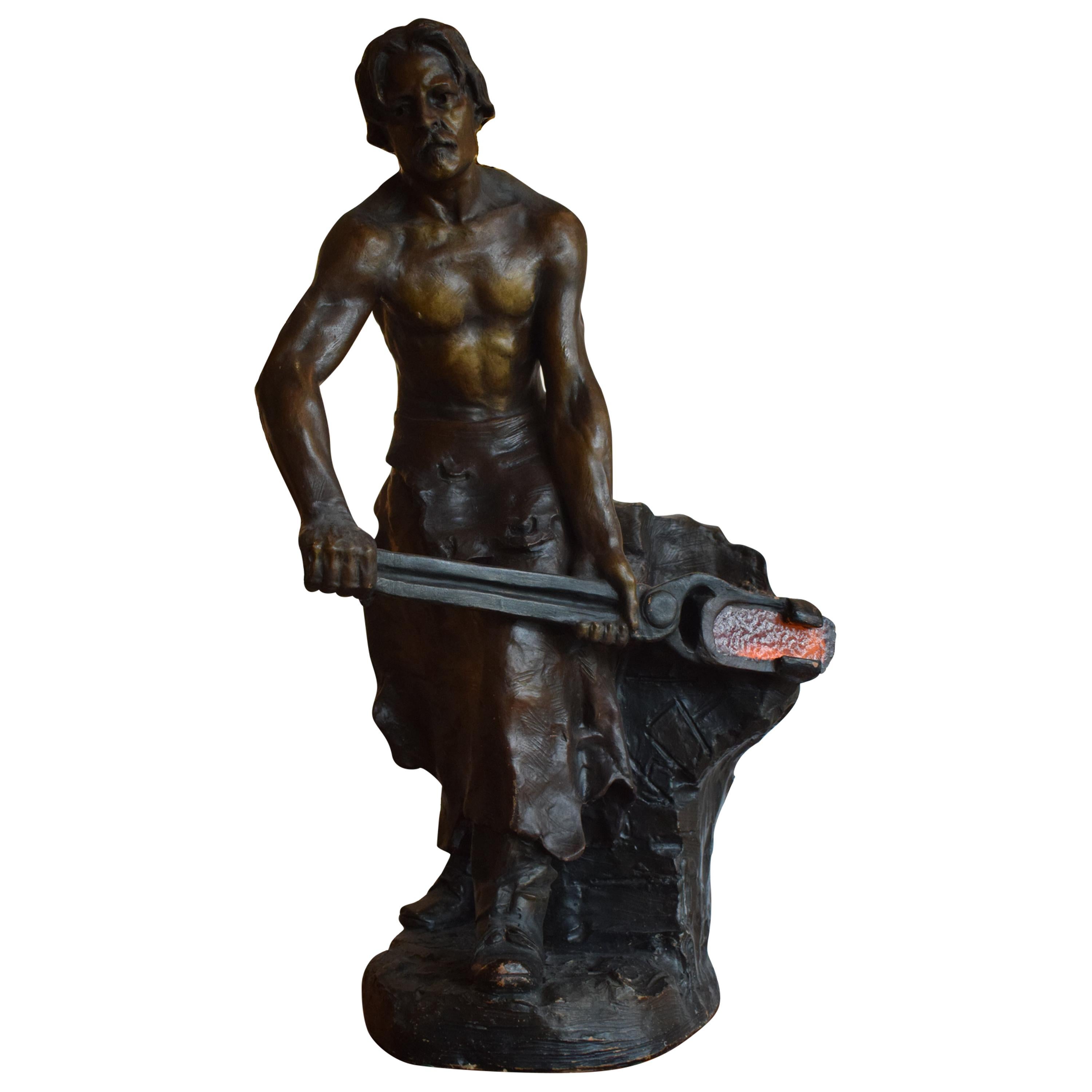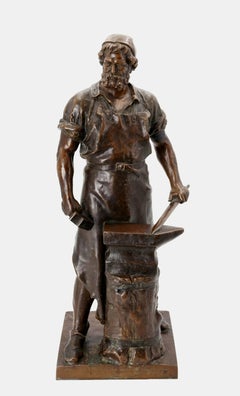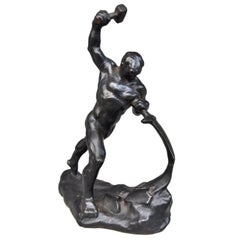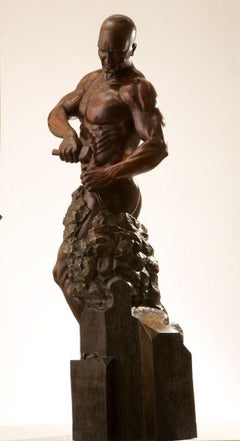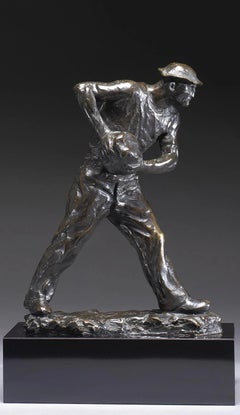Items Similar to The Foundry Worker
Want more images or videos?
Request additional images or videos from the seller
1 of 10
Albert CaasmannThe Foundry Workerc.1925
c.1925
$2,000
£1,546.92
€1,761.08
CA$2,871.68
A$3,137.40
CHF 1,644.32
MX$37,461.50
NOK 20,809.02
SEK 19,403.98
DKK 13,152.43
About the Item
This sculpture "The Foundry Worker" c.1925 is a bronze sculpture by German artist Albert Caasmann, 1886-1968. The signature is impressed in the bronze. The subject size is 11.15 x 8.15 x 3.15 inches, including marble base, the size is 13.15 x 8.15 x 5 inches. It is in excellent condition.
about the artist:
Albert Caasmann (2 June 1886 – 23 March 1968) was a German sculptor and porcelain artist. Caasmann designed toy figures for the Berlin toy company Lineol and from 1919 to 1952 was the lead designer and production manager for the company. He designed figurines for the porcelain companies Rosenthal AG and Volkstedt. Caasmann's work for the company Rosenthal are exhibited in the Porzellanikon's Rosenthal Museum. Lineol toy figures modeled by Caasmann are in the Historical Toy Museum in Freinsheim and the Toy museum in Havelland.
Albert Caasmann was born on 2 June 1886 in Berlin, Germany. From 1909 to 1919, he worked as a freelancer for the Berlin toy company Lineol, founded by Oskar Wiederholz in 1906. After service as a soldier in the First World War, he became the leading designer and production manager of Lineol from 1919 to 1952. He designed over 600 figures for Lineol, including soldiers, animals, Indians, knights, fairy figures, and railroad figures. His toy figures were widely used in the region by children. Lineol ceased operations in 1965, and in 1985 the company Lineol Duscha has the trademark rights to Lineol. Lineol Duscha reproduces Lineol figures modeled before 1945. Lineol toy figures modeled by Caasmann are in the Historical Toy Museum in Freinsheim and the Toy museum in Havelland.
Caasmann spent time in the Berlin Zoo, where he modeled his animal models. He made a model for a porcelain cheetah group, manufactured by the Rudolstadt, Thuringia, German porcelain company Volkstedt. From 1912–1923, he modeled figurines based on his own designs for the porcelain manufacturer Rosenthal AG in Selb. In 1923 he modeled four figurines based on the paintings by Austrian painter Hanns Pellar for Rosenthal. The figurines Caasmann modeled for Rosenthal based on Pellar's paintings were Dreaming Night, Faun Group, Round Dance, and Shepard's Hour, Caasmann's work for the company Rosenthal are exhibited in the Porzellanikon's Rosenthal Museum.
Cassman died on 23 March 1968 in Brandenburg, East Germany. The street Caasmannstraße in Brandenburg was named by the city in honor of Albert Caasmann.
- Creator:Albert Caasmann (1886 - 1968, German)
- Creation Year:c.1925
- Dimensions:Height: 13.15 in (33.41 cm)Width: 8.15 in (20.71 cm)Depth: 5 in (12.7 cm)
- Medium:
- Movement & Style:
- Period:
- Condition:
- Gallery Location:San Francisco, CA
- Reference Number:Seller: caa/fou/wor/011stDibs: LU666312973872
About the Seller
5.0
Platinum Seller
Premium sellers with a 4.7+ rating and 24-hour response times
Established in 1999
1stDibs seller since 2017
864 sales on 1stDibs
Typical response time: <1 hour
- ShippingRetrieving quote...Shipping from: San Francisco, CA
- Return Policy
More From This Seller
View AllThe Athlete and his Coach
Located in San Francisco, CA
This artwork Titled "The Athlete and his Coach" is a bronze sculpture by noted California artist Kenneth Johnson, born 1945. The size, base not included is...
Category
Late 20th Century American Realist Figurative Sculptures
Materials
Bronze
Untitled, Old woman looking a naked man sculpture
By Charles Bragg
Located in San Francisco, CA
This artwork is an original etching by noted American artist Charles Bragg, 1931-2017. It is signed and numbered 166/300 in pencil by the artist. The image (plate mark) size is 8 x 6...
Category
Late 20th Century Other Art Style Figurative Prints
Materials
Etching
Speaks with Forked Tongue
By Gordon Phillips
Located in San Francisco, CA
This artwork titled "Speaks with a forked tongue" c. 1970, is a bronze sculpture by renown American Western artist Gordon Dale Phillips, 1927-2011. It is signed and numbered 37/40 on...
Category
Late 20th Century American Realist Figurative Sculptures
Materials
Bronze
Group of Workers
By John Edward Costigan
Located in San Francisco, CA
This artwork titled "Group of Workers" 1943, is an original lithograph on paper by noted American artist John Edward Costigan, 1888-1972. It is hand signed and titled in pencil by th...
Category
Mid-20th Century Realist Figurative Prints
Materials
Lithograph
Arabesque, Ballet Dancer
Located in San Francisco, CA
This sculpture titled "Arabesque (Ballet Dancer)" 2001 is a cast bronze sculpture with silver patina by noted contemporary American artist Rebecca Clark. Signature, date and numbering /500 are impressed in the bronze on the deck. The sculpture size without the marble base is 28.25 x 17.75 x 13 inches, with the marble base is 29.5 x 17.75 x 13 inches. It is in mint condition.
About the artist:
Rebecca A. Clark is a Fine Artist and Creative Director with over 20 years of professional experience working in the fine art field in New York City. Her masterful artworks are collected by prominent art collectors worldwide. Rebecca specializes in figurative bronze sculptures, oil paintings, drawings and monumental works of art that embody dynamic strength and classic iconic beauty.
Her artworks range from sensuous figurative sculptures to magnificent heroic size monuments. Commissioned works include “Battling Stallions”, her 18 ft. tall monumental bronze sculpture at the luxury gated development “Le Chevalier” in Barrington Heights, West Linn, Oregon, as well as her elegant 9 ft. tall ballerina bronze sculpture titled “Arabesque” on public display at the Oregon Ballet Theatre. Exclusive custom created works of art portray diverse concepts and themes for private and corporate collectors. Signature series include: Heroic series (Honoring American military Heroes), Inspirational, Classic Nudes and Romantic among other series and sculpture projects in development.
Rebecca was born an artist and has always had the desire to achieve excellence in all of her endeavors. From a very early age she was immersed in imaginative creative works such as building models of futuristic cities, paintings, sculptures and a multitude of drawings. In 1981, at the age of 17, Rebecca moved from Lake Oswego, Oregon to New York City to pursue a career in fine art and design at the Parsons School of Design. Shortly after she arrived, Rebecca began her professional artistic career assisting the renowned illustrator Antonio Lopez. At age 18, Rebecca was hired by the famed designer Halston, and began working directly with him as a fashion designer and illustrator. Subsequently, she was discovered by the Ford Models agency and traveled around the world as a top international fashion model. Rebecca worked with renowned fashion photographers such as Richard Avedon, Bruce Weber, Steven Meisel, Patrick Demarchelier and others. Rebecca is experienced in working with the major media, including international publications such as Vogue, Harpers Bazaar, Elle, The New York Times and Glamour, among others, as well as in television. She was featured in a national Diet Slice-Style television commercial that was shown during halftime at the 1987 Super Bowl. Rebecca also appeared in top fashion shows in New York City and Paris, France and in international advertising campaigns such as Revlon’s “The Most Unforgettable Women In The World” ads photographed by Richard Avedon.
In 1991, Rebecca left a prestigious modeling career to return to her true creative passion. She began creating a series of beautiful and universally appealing fine bronze sculptures and many commissioned works. In 1998, she began oil painting and studied at the New York Academy of Art, while creating oil paintings depicting the classic nude, equine, inspirational themes and portrait commissions for select art collectors. In 2001, Rebecca developed several digital film projects through her studies in the Film Directors Program at New York University. From 2001 to the present, she continues to create bronze sculptures, drawings, and oil paintings for private art collectors.
In 2011, Rebecca was officially endorsed and directed by the National Special Forces Association to create The National Special Forces Green Beret...
Category
21st Century and Contemporary American Realist Figurative Sculptures
Materials
Bronze
Graceness
By Lajos Flesser
Located in San Francisco, CA
This artwork titled "Graceness", done in 1997 is an oil painting on canvas by noted Hungarian artist Lajos Flesser, b.1937. It is signed, titled and dated in the back by the artist. The canvas size is 21.75 x 18 inches, framed is 23.25 x 19.75 inches. Custom framed in a wooden black and gold frame.The artwork is in excellent condition. The frame is in good condition, with a few scuffs to the gold. Please see the final two images for the imperfections.
About the artist:
Lajos Flesser was born on Aug. 11, 1937 in Budapest, where he grew up in the shadow of World War II. In his late teens he studied at trade school, concentrating on metal skills. His need of communication made him start boxing, and the success was long in coming. In boxing circles, Flesser became a well established name with a couple of Hungarian championships.
Then came the fatal year 1956, when Soviet tanks crushed the dreams of freedom. Flesser escaped and came to Sweden via Denmark.
In Gothenburg the well known boxing promoter Edvin Alqvist soon became aware of Flesser's capacity as a boxer and offered him a contract. His debut occurred in May 1957...
Category
Late 20th Century Modern Nude Paintings
Materials
Oil
You May Also Like
The Blacksmith of Solingen / - The Double-edged Sword -
Located in Berlin, DE
Wilhelm Albermann (1835 Werden an der Ruhr - 1913 Cologne), The Blacksmith of Solingen, after 1895. Bronze-color patinated zinc cast on plinth, 47 cm (height) x 20 cm (width) x 16 cm (depth), weight 5.5 kg. Signed “Albermann.” on the plinth and identified as a cast by “AKT.[TIEN] GES.[ELLSCHAFT] GLADENBECK BERLIN”. Dedication on the front: “Mr. Ing. F. Kuhlmann to the wedding. Management and officials of the Hannoversche Waggonfabrik. Aircraft construction department".
- The zinc showing through in spots, the patina somewhat stained, the right upper arm under the sleeve retouched in black.
- The Double-edged Sword -
The figure is a reduction of Wilhelm Albermann's 1895 fountain figure of the armourer of Solingen, who has always been identified with the historical blacksmith Peter Hahn. In 1839, Karl Simrock wrote the poem “The Blacksmith of Solingen" and thus coined the legendary figure. The first and penultimate verses read:
A blacksmith spoke to Solingen
With every bayonet,
That came to his diligence:
"Oh, that Fritz had it!"
The war took its course,
Many battles were fought,
Which often made him fearful and anxious
In his soul.
The blacksmith had given up his trade to fight for Frederick the Great. Not least because of his strength and will to fight, the battles were won. With his fountain sculpture, Albermann has given the legendary blacksmith a figurative form and at the same time created a landmark for the city of Solingen, which was once famous for the art of sword forging and today still stands for the production of high-quality knives. During the bombing raid in November 1944, the fountain was destroyed along with the entire old town of Solingen. Only the head remained.
The broad-shouldered blacksmith stands securely behind his anvil, his leather apron tied around him, and has just finished a sword blade with his own "weapon" - the blacksmith's hammer. His entire body shows the strength with which he wields the hammer, but also the strain of this activity, as evidenced by the wide open shirt, the somewhat 'untidy' apron, and especially the furrowed face.
However, the blacksmith does not look at the finished work, but resolutely and at the same time thoughtfully into the distance, in line with the quoted verse from Simrock's poem that the battles "often made him fearful and anxious in his soul". There is certainly something melancholy in his gaze, fed by the knowledge of the necessity of forging swords and taking up arms and their deadly use - experiences Albermann had to make during his own war missions. The flowing full beard gives his gaze into the distance an almost prophetic character.
In keeping with the craft of the perfectly formed art of blacksmithing, the detailed casting reproduces the respective materials depicted in perfect form: the leather apron convincingly conveys the impression of leather and lies - also in the back view - like a second formed layer over the body, while the shirt and trousers illustrate their own textile qualities.
Due to its masterful execution and profound content, the “Blacksmith of Solingen”, which has survived in its cast reproductions, remains Albermann's most famous work to this day.
About the artist
The son of a carpenter, Wilhelm Albermann began an apprenticeship as a joiner, but then followed his artistic calling and trained as a sculptor in Elberfeld. In 1855, at the age of twenty, he was drafted into the army in Berlin, where he served until 1857. Albermann attended the Berlin Art Academy on the side and began regular studies after his service. While still a student, he completed commissioned works for his teachers August Fischer and Hugo Hagen. His first independent commissions followed, enabling him to establish a flourishing sculpture studio in Cologne in 1865. His artistic activities were repeatedly interrupted by military service, and he took part in the German-Danish War in 1864, the war against Austria in 1866, and the Franco-Prussian War in 1870/71. After his last war service, Albermann, already a respected artist, founded a commercial drawing school at the request of the city government, where he taught the modeling class and served as director until 1896. In 1890 he also worked for the "Society for the Promotion of Sculpture in the Rhineland and Westphalia".
Albermann was one of the most prolific sculptors in Cologne in the second half of the 19th century. He created numerous monuments, fountains, tomb sculptures, architectural ornaments, and domestic statues. At its peak, his workshop employed up to thirty sculptors and stonemasons at a time.
GERMAN VERSION
Wilhelm Albermann (1835 Werden an der Ruhr - 1913 Köln), Der Schmied von Solingen, nach 1895. Bronzefarben patinierter Zinkguss auf gegossener Plinthe, 47 cm (Höhe) x 20 cm (Breite) x 16 cm (Tiefe), Gewicht 5,5 kg. Auf der Plinthe mit „Albermann.“ signiert und als Guss der „AKT.[TIEN] GES.[ELLSCHAFT] GLADENBECK BERLIN“ ausgewiesen. Schauseitige Widmung: „Herrn Ing. F. Kuhlmann zur Vermählung. Direktion und Beamte der Hannoverschen Waggonfabrik. Abt. Flugzeugbau“.
- Punktuelles Durchscheinen des Zinks, Patina etwas fleckig, der rechte Oberarm unter dem Ärmel schwarz retuschiert.
- Die Zweischneidigkeit des Schwertes -
Die Figur ist eine Reduktion von Wilhelm Albermanns 1895 geschaffener Brunnenfigur des Waffenschmieds von Solingen, der seit jeher mit dem historischen Schmied Peter Hahn identifiziert wurde. 1839 hatte Karl Simrock das Gedicht „Der Schmied von Solingen“ verfasst und damit die legendäre Figur geprägt. Die erste und die vorletzte Strophe lauten:
Zu Solingen sprach ein Schmied
Bei jedem Bajonette,
Das seinem Fleiß geriet:
»Ach, daß der Fritz es hätte!«
Der Krieg ging seinen Gang,
Man schlug noch viele Schlachten,
Die oft ihm angst und bang'
In seiner Seele machten.
Der Schmied hatte sein Handwerk ruhen lassen, um selbst für Friedrich den Großen zu kämpfen. Nicht zuletzt durch seine Kraft und seinen Kampfeswillen verliefen die Schlachten siegreich. Dem legendären Schmied verlieht Albermann mit seiner Brunnenskulptur eine bildliche Gestalt und schuf damit zugleich ein Wahrzeichen der Stadt Solingen, die einst für die Kunst des Schwerterschmiedens berühmt war und bis heute für die Herstellung qualitätvoller Messer einsteht. Beim Bombenangriff im November 1944 wurde mit der gesamten Solinger Altstadt auch der Brunnen zerstört. Einzig der Kopf blieb erhalten.
Mit sicherem Stand und umgebundener Lederschürze steht der breitschultrige Schmied hinter seinem Amboss und hat gerade mit seiner eigenen ‚Waffe‘ – dem Schmiedehammer – eine Schwertklinge fertiggestellt. Seinem gesamten Körper ist die Kraft abzulesen, mit der er den Hammer führt, aber auch die Anstrengung dieser Tätigkeit, wovon das weit geöffnete Hemd, die etwas ‚unordentlich‘ arrangierte Schürze und vor allem das zerfurchte Gesicht zeugen.
Der Schmied schaut aber nicht auf das vollendete Werk, sondern entschlossen und zugleich sinnierend in die Ferne, entsprechend der zitierten Zeile von Simrocks Gedicht, dass die Schlachten „oft ihm angst und bang‘ in seiner Seele machten“. Der Blick hat durchaus etwas Melancholisches, dass sich aus dem Wissen um die Notwendigkeit, Schwerter zu schmieden und zu den Waffen zu greifen und deren tödlichem Einsatz speist – Erfahrungen, die Albermann bei seinen eigenen Kriegseinsätze machen musste. Der wallende Vollbart verleiht dem in die Ferne schauenden Blick einen beinahe prophetischen Charakter.
Dem Handwerk der formvollendenden Schmiedekunst entsprechend, gibt der detaillierte Guss die jeweils dargestellten Materialien in vollendeter Ausformung wieder: Die Lederschürze vermittelt überzeugend den Eindruck des Leders und liegt – auch in der Rückenansicht – wie eine zweite ausgeformte Schicht über dem Körper, während das Hemd und die Hose...
Category
1890s Realist Figurative Sculptures
Materials
Metal
$1,323 Sale Price
20% Off
Man with Effort Cast Iron, 1976
Located in Marseille, FR
Man at the effort Expressionist cast iron dated and signed 1976 with a height of 28 cm for a width of 21 c and a depth of 10 cm.
Additional information:
Material: cast iron (iron...
Category
20th Century Figurative Sculptures
Materials
Iron
Master of Your Own Destiny II by Walter Peter Brenner - Mythological, bronze
By Walter Peter Brenner
Located in Paris, FR
Master of Your Own Destiny II is a bronze sculpture with brown patina made of iron nitrate with a wax finish sculpture by contemporary artist Walter Peter Brenner, dimensions are 125...
Category
2010s Contemporary Figurative Sculptures
Materials
Bronze
"Road Builder" 20th Century Modern WPA Labor Bronze WPA Depression-Era Sculpture
By Max Kalish
Located in New York, NY
Max Kalish
The Road Builder
inscribed M. KALISH 23, with Meroni-Radice foundry mark, on top of base bronze with dark brown patina, on an ebonized rectangular plinth
Height: 13 1/8 in. not including base
Provenance: Spanierman Gallery, New York
BIO
Max Kalish (1891 – 1945)
Born in Poland March 1, 1891, figurative sculptor Max Kalish came to the United States in 1894, his family settling in Ohio. A talented youth, Kalish enrolled at the Cleveland Institute of Art as a fifteen-year-old, receiving a first-place award for modeling the figure during studies with Herman Matzen. Kalish went to New York City following graduation, studying with Isidore Konti and Herbert Adams...
Category
1920s American Realist Figurative Sculptures
Materials
Bronze
Prototype of Blacksmith by Wessel Couzyn
Located in Asbury Park, NJ
A prototype by Dutch sculptor Wessel Couzyn in plaster depicting a blacksmith with hammer. Signed at base.
Couzyn attended the Dutch Royal Academy of Plastic Arts in the late 1930s and was awarded the Prix de Rome in that time to study in Italy. Some bronze works can be found at the Jewish Heritage...
Category
Vintage 1930s Dutch Art Deco Figurative Sculptures
Sculpture of Blacksmith
Located in Atlanta, GA
"Blacksmith" A patinated terracotta sculpture Luminaire signed R. Aurili, France, circa 1920.
Dimensions: Height 29", width 14 1/2", depth 14"
NI243
R. Aurili was a 19th century sculptor who came from Naples and exhibited in the Salon de Paris...
Category
Vintage 1920s French Figurative Sculptures
Materials
Terracotta
$2,600
More Ways To Browse
Antique Rosenthal
Antique Bronze Sculpture Artists
Worker Bronze
Dancing Faun
Sculpture Worker
Antique Cheetah
Thuringia Porcelain
Albert Toft
Apple Fiberglass
Aquila Van Der Kant
Arman Saxophone
Arman Venus
Arsham Brillo
Austin Productions 1961 After Modigliani Sculpture Tete De
Barbara Lekberg
Bastion Sculpture
Bearbrick Van Gogh
Betsy Popsicle
